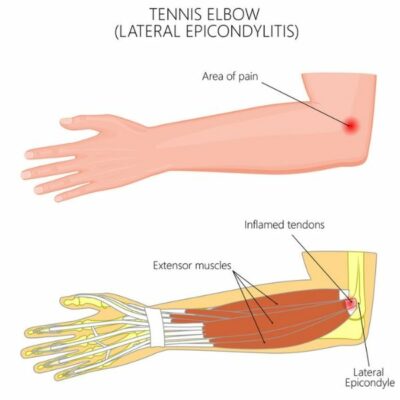Tennis Elbow Specialist

Are you an athlete who participates in tennis, racquet sports or activities requiring repetitive motions? If so, you are at an elevated risk of developing tennis elbow. Tennis elbow is characterized by small tears in the tendon from continuous overuse of the arm and forearm muscles, leading to pain and tenderness on the outside of the elbow. Tennis elbow specialist, Dr. James Mazzara provides diagnosis and both surgical and nonsurgical treatment options for patients in Manchester, South Windsor, Enfield, Glastonbury and surrounding Hartford communities who have symptoms of tennis elbow. Contact Dr. Mazzara’s team today!
Tennis Elbow – Lateral Epicondylitis
What is Tennis Elbow?
Tennis Elbow, also called lateral epicondylitis is a condition marked by small tears in the tendons that surround the elbow area. It is caused by overuse of the arm and forearm muscles which can lead to pain and tenderness on the outside of the elbow. Manchester, South Windsor, Enfield, Glastonbury and surrounding Hartford communities elbow specialist, Dr. James Mazzara, can assist patients who are experiencing tennis elbow and offer treatment that will help ease the painful condition.
Despite its name, athletes aren’t the only people who may experience tennis elbow. Repetitive arm and forearm movements cause this injury in plumbers, carpenters, painters, butchers or gardeners. Lateral epicondylitis may also occur from a fall, automobile accident, or laborers who use heavy tools and workers engaged in repetitive gripping or lifting tasks.hange this text.
What are the symptoms of tennis elbow?
- Pain and tenderness on the outside of the elbow
- A weak grip due to pain
- Pain when making a fist or grasping an object
- Persistent ache on the outside of the elbow and the top of the forearm
The pain associated with tennis elbow may radiate from the outside of your elbow into your forearm and wrist. Pain and weakness may make it difficult to:
- Grasp items
- Carry a purse or briefcase
- Shake hands
- Lift an object
- Turn a knob
- Hold a coffee cup
- Picking up something with the palm facing downward.
It is common in laborers who use heavy tools and workers engaged in repetitive gripping or lifting tasks.
When should you see a doctor for tennis elbow?
Tennis elbow does not usually lead to serious problems. However, if normal measures such as rest, ice, and over-the-counter medication have not helped relieve the pain, it may be a benefit to Dr. James Mazzara, elbow specialist. You will want to inform him right away if the following conditions develop:
- Weakness or numbness in the hand (could mean a different type of injury.)
- Pain that limits daily activity.
- Tennis elbow symptoms that do not subside after several days.
How is lateral epicondylitis diagnosed?
Dr. Mazzara will conduct a thorough physical examination and medical review of the patient’s history. He will inquire about the possible causes of tennis elbow, rather it be work related, due to a sports activity, or caused by an accident. During the physical exam, he will apply pressure to different areas of the arm and elbow as well as test strength and pain levels. Most commonly, tennis elbow is diagnosed by pain when palpating directly over the area of the lateral epicondyle. Dr. Mazzara may recommend a series of X-rays and an MRI to rule out any bone injuries or associated elbow injuries.
Does tennis elbow require surgery?
Tennis elbow often gets better on its own. However, if over-the-counter pain medications and other self-care measures aren’t helping, Dr. Mazzara may suggest physical therapy or a special brace. If the injury is related to overuse, eliminating the activity all together for a duration of time will often heal the injury. Other non-surgical treatment options include a cortisone injection and platelet rich plasma (PRP) injections.
How is tennis elbow treated with surgery?
If left untreated, or if there is further tendon damage, tennis elbow may require surgical intervention. Typically, the surgery used to repair torn tendons in the elbow is done through a small incision on the outside of the elbow. Dr. Mazzara can repair the damage and return patients to their normal activities with this innovative treatment technique. Patients are encouraged to return to normal activities as pain permits 48 hours after surgery.
If you have symptoms of tennis elbow or if you would like further information about lateral epicondylitis, please contact the orthopedic office of Dr. James Mazzara, elbow specialist, serving patients living in Manchester, South Windsor, Enfield, Glastonbury and surrounding Hartford Connecticut communities.

